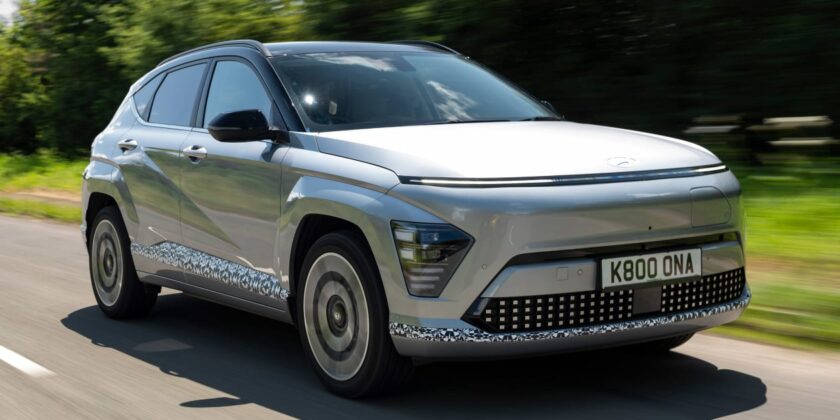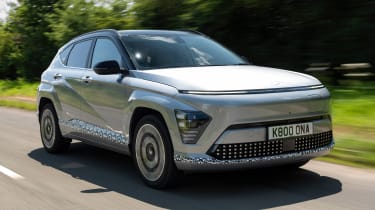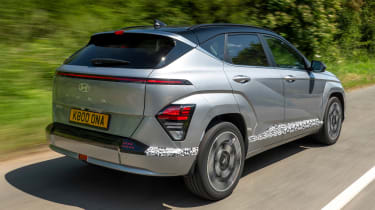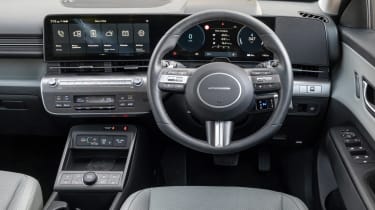The second-generation Hyundai Kona Electric is bigger and posher than ever
5.0 out of 5
Buy used for less at Buyacar
Verdict
The new Hyundai Kona Electric is a fantastic example of how a brand can listen to feedback and act upon it. Hyundai has grown its small SUV sensibly, delivering just enough additional practicality to go along with a far more polished cabin feel and neatly integrated tech. There may be cheaper EVs on cash and finance, but right now, the Kona looks extremely good value for a notably mature and well rounded offering in a fast-developing market.
Hyundai scored such a massive hit with its Ioniq 5 that it’s easy to forget the brand’s earlier EV efforts. There was the Prius-rivalling model called Ioniq, but also the Kona, a small SUV offered with a choice of hybrid powertrains or as a pure-electric version. Now there’s a second generation of the car, and we’ve grabbed an early chance to drive it in the UK.
Buyers loved lots about the original Kona, but many reckoned it was a little too compact. Hyundai has responded to this by moving the car onto the same K3 platform as the likes of the Kia Niro, and stretching its length and wheelbase. The end result is a car that now sits halfway between a Nissan Juke and a full family SUV, instead of one that was barely a jacked-up supermini, previously.
More reviews
Car group tests
- MG ZS EV vs Hyundai Kona Electric: 2022 twin test review
- Hyundai Kona N vs Ford Puma ST: 2022 twin test review
- Hyundai Kona Electric (2018-2023) review
- Hyundai Kona (2018-2023) review
- Hyundai Kona (2018-2023) review
- New Hyundai Kona N 2021 review
- Used Hyundai Kona (Mk1, 2017-date) review
In-depth reviews
Road tests
Used car tests
The Kona really does look like a mini Tucson from certain angles, too, thanks to complex surfacing along the flanks – especially around the rear wheelarches, which some may find a little fussy. But there’s a sleek sci-fi look to the front end, with its wraparound pixel bar.
Inside, the pair of 12.3-inch displays that dominate the facia are lifted pretty much straight from other Hyundais, but they run new software here, with a cleaner interface that features larger and easier-to-prod ‘widgets’.
The rest of the cabin feels notably more upmarket than the previous Kona; there are soft-touch finishes on all of the key surfaces, and robust, well made plastics where they’re needed, in heavy-use areas. The open interior architecture also means storage is great.
The Kona Electric will be available with a 48kWh or 65kWh (both usable capacities) battery, powering a 154bhp or 215bhp front-mounted motor, respectively. Both set-ups get the same 255Nm of torque.
The big-battery version has a claimed range of 305 miles; we’re still waiting for precise charging specifications but we do know that topping up the battery from 10 to 80 per cent takes 43 minutes.
The good news is that, over several days of mixed driving on motorways, A-roads and urban rat runs, the Kona showed every sign of getting pretty close to that stated range. And unlike many of its rivals – including, notably, the Kia Niro – all UK Kona Electrics will get an efficiency-boosting heat pump as standard, making it more likely to repeat this feat in colder conditions.
The increased level of maturity extends beyond the Kona’s cabin and into its driving dynamics, because Hyundai’s take on the K3 platform has been to deliver as much comfort as possible, while ensuring the body stays tied down. While there is a little bit of patter on busier surfaces, the Kona is admirably compliant at lower speeds around town, occasionally requiring a second nod to settle after speed bumps, but still managing to isolate you from the worst of the impacts over them.
There’s not much scope for involvement, but then this is par for the class. The steering is consistently weighted but short on feel, and if you start throwing the Kona around on a back road, it soon loses a little of its composure. Refinement is excellent, with well suppressed wind and road noise. It’s a doddle to drive around town, too.
There’s much more space inside – particularly in the rear – and the Kona now feels like the family car it always should have been, with solid amounts of leg, knee and headroom. The same goes for the boot; its capacity is now 466 litres.
In terms of trims, Advance is the starting point (and your only port of call if you’re after a smaller-battery edition). It gets 17-inch alloys, dual-zone climate control, all-round parking sensors with a rear-view camera, dual 12.3-inch displays, vehicle-to- load functionality (complete with a three-pin plug socket for charging gadgets), four USB-C ports and full-LED headlights.
The £600 Comfort pack adds heated front and rear seats, a heated steering wheel, a wireless smartphone-charging pad and privacy glass. Frankly, it’s hard to see many buyers needing any more than this. N Line and N Line S will follow in early 2024, delivering a more sporting theme to the styling, while top-spec Ultimate will get a similar list of add-ons to the sportier cars (sunroof, remote park assist and a digital key), but does without the N Line look.
The 65kWh Advance costs £38,595 – or around £2,000 less than the cheapest Niro EV with a heat pump. Jeep’s Avenger starts at a fair bit less and does get a heat pump as standard – but it’s quite a bit smaller and around 40 miles shy of the Kona’s range in everyday use. Perhaps more importantly, based on a four-year deal and with a 25 per cent deposit, the cheapest 65kWh Kona Electric will cost you less than £400 a month.
| Model: | Hyundai Kona Electric 65kWh Ultimate |
| Price: | £43,055 |
| Powertrain: | 65kWh battery/1x e-motor |
| Transmission: | Single-speed automatic, front-wheel drive |
| Power/torque: | 215bhp/255Nm |
| 0-62mph: | 8.0 seconds |
| Top speed: | 104mph |
| Range/charging: | 305 miles/100kW (10-80% 43 mins) |
| On sale: | Now |
Source: Read Full Article




